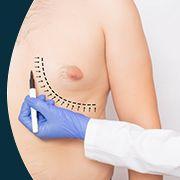Does Lipoma Surgery Leave a Scar? Understanding Post-Surgical Scarring
In This Article
Does Lipoma Surgery Leave a Scar? Understanding Post-Surgical Scarring
Elena
Updated on May 21, 2024
Medically verified by Dr. Arya
Fact checked by Dr. Pournami

Cosmetic
7 min read
Well you have come to the right place
Lipomas, a benign growth of fat cells, are a lump of fat just under the skin. Lipomas move easily when you touch them and feel rubbery, not hard.
While they are not harmful typically, lipoma may lead to surgery due to cosmetic concerns, discomfort, size increase or even due to suspicion of cancer.
In this blog we will be discussing the ins and outs of lipoma, the surgery procedure and how to minimise the scarring after the surgery.
What Are Lipomas and Why Consider Surgery?
Lipomas are benign tumours composed of adipose tissue, commonly found in subcutaneous tissue, shoulders, neck, arms, and back.
Typically painless, soft, and movable, lipomas may prompt surgical intervention due to cosmetic concerns, discomfort, size increase, or suspicion of cancer.
- Discomfort of the lipoma and cosmetic concerns leads to surgery.
- Lipomas are benign growths composed of fat cells.
- Lipomas can be seen in various parts of your body.
- Surgery is also considered in the case of increase in size or due to discomfort.
Preoperative Preparation: Understanding the Procedure
Consulting a surgeon before undergoing lipoma surgery takes first priority. During this consultation, patients can discuss their concerns, expectations and about surgical options that are available.
Based on the consultation, the surgeon will do an evaluation of the patient before the surgery which can include one's previous medical history.
Patients should be well aware of the risks and benefits of the surgery as well as have a realistic expectation of what will be the outcome of the surgery.
- Consulting a surgeon to understand about lipoma and surgery options takes first priority .
- Evaluation will be conducted prior to the surgery to understand the patient's medical history.
- Physical examinations will be done before the surgery.
- Patients should thoroughly understand the risks and benefits of the surgery.
- Patient should also have realistic expectation about the surgery outcome
During Surgery: The Procedure and Techniques
Lipoma surgery is usually performed under local anaesthesia or general anaesthesia, depending on the procedure and the preference of the patient.
The surgeon makes strategic incisions to access the lipoma, employing techniques to remove the growth while preserving surrounding tissues.
Various surgical techniques may be used, including direct excision, liposuction-assisted excision, or minimal access surgery.
The choice of technique depends on factors such as the size and location of the lipoma.
- The surgery is performed under local or general Anesthesia .
- Calculated incisions are made to access lipoma.
- Techniques are used to preserve the surrounding tissues.
- Closure with sutures to optimise maximum healing of the wound.
Factors Influencing Scarring:
There are several factors influencing the extent and appearance of scarring after lipoma surgery:
- Size and Location of the Lipoma: Larger lipomas may require larger incisions, which can result in more noticeable scarring.
Lipomas located in areas such as the forehead or shins, may also lead to more prominent scars.
- Surgical Technique: The surgical technique used to remove the lipoma can impact the scarring.
Direct excision, liposuction-assisted excision, or minimal access surgery may be employed, depending on factors such as the size and location of the lipoma.
- Surgeon Skill and Experience: The skill and experience of the surgeon performing the procedure can influence the outcome of scarring.
- Wound Care and Scar Management: Proper care for the wound and scar management techniques following surgery play a very crucial role in reducing the scarring.
Patients must follow their surgeon's instructions regarding wound care, including keeping the incision clean and dry and avoiding activities that may interrupt the healing.
 9 min read
9 min readThe Advantages of Choosing Mykare Health for Gynecomastia Surgery
 6 min read
6 min readIdentifying The Ideal Age For Gynecomastia Surgery
 6 min read
6 min readPre and Post Gynecomastia Surgery: Essential Things to Know
Get a Callback Now
Minimising Scarring
While some scarring is inevitable after any surgical procedure, there are several strategies to minimise scarring after lipoma surgery:
- Silicone Gel Sheets: these are one of the most common scar management options recommended by healthcare professionals.
The gel sheets can form a protective layer over which will help in maintaining the moisture and have a good healing condition.
- Scar Massage: giving the scar a massage regularly in circular motion will help in breaking down the scar tissues and improve its appearances. The massage should be very gentle and should only be done after the scar is completely healed
- Sun Protection: UV radiations can cause the scar to darken, in order to prevent that use sunscreen with High SPF and try to avoid gettin sun rays directly to the scar.
- Scar Creams and Gels: Those which contain onion extract or vitamin E can help reduce scarring. However, patients should consult their healthcare provider before using any scar treatment products.
- Laser Therapy: Laser is usually used by targeting the scar tissues which can improve the appearance of the skin, but to get a satisfactory result multiple sessions are needed.
- Surgical Revision: In the situation where the scar is very visible or bothersome , surgical revision can be considered. In this procedure the scar tissue is removed and is reclosed to minimise scarring.
Postoperative Care: Minimising Scarring and Promoting Healing
After lipoma surgery, patients receive detailed wound care instructions to keep the incision clean and dry.
Pain management medications are prescribed as needed to alleviate discomfort. Scar management techniques are implemented to minimise scarring and optimise wound healing.
These techniques may include the use of silicone gel sheets, scar massage, and sunscreen to protect the incision site from UV exposure.
Follow-up appointments are scheduled to monitor healing progress and address any concerns or complications that may arise.
- The patients are provided with detailed wound care instruction.
- Pain management medications are prescribed.
- Scar management techniques such as using silicone gel sheets, using sunscreen and so on are implemented.
- Follow-up appointments are done to monitor healing.
Recovery and Long-Term Results: What to Expect
During the recovery period, patients may experience initial discomfort and swelling, which gradually subside over several weeks.
The appearance of the scar evolves from initially red or raised to mature and faded over time. Ultimately, lipoma surgery results in improved appearance, relief from discomfort, and restored confidence for many patients.
Long-term follow-up is important for monitoring scar maturation, addressing any residual symptoms, and ensuring overall satisfaction with the results.
- The initial discomfort and swelling of the tissue will reduce after weeks.
- The scar will seem red and raised initially but it will fade and mature eventually.
- It will improve the appearance and give relief from discomfort.
- It can restore the confidence of many people.
Empowering Patients with Knowledge
Even though not harmful, Lipoma surgery can be life changing to many people especially people who are conscious about its looks or people who are suffering from its discomfort.
By thoroughly understanding and getting educated about the surgery and its consequences from the surgeon, the patient can prepare for the surgery. By taking advice and caring for your wound after treatment people can also reduce the post surgery scar.
It is very essential that the patient keep very good communication with the healthcare staff to understand about the surgery procedures as well as to tell openly about their medical history.
Embracing a healthy lifestyle as well as following the instruction of the healthcare staff can lead to an optimal healing.
Visit Mykare Health to know more about Lipoma.
Lipomas are benign growths of fat cells,which usually not harmful but may cause discomfort or cosmetic concern
Consultation and evaluation about one's lipoma as well as understanding the pros and cons of surgery is necessary .
Lipoma surgery is typically performed under local anaesthesia or general anaesthesia.
Careful incisions and preservation of surrounding tissues help minimise scarring during surgery.
Postoperative care, including wound care and scar management techniques leads to desired healing.
Recovery involves gradual resolution of discomfort, swelling, and scar maturation.
Follow-up post surgery is important for monitoring scar maturation and ensuring overall satisfaction with the results.
Patients should communicate openly with their healthcare providers throughout the surgical process and recovery period.
Embracing a healthy lifestyle, including proper nutrition and regular exercise, can contribute to optimal healing outcomes after lipoma surgery.
Source Links
Cleveland Clinic
Mayo Clinic
World Health Organization (WHO)



